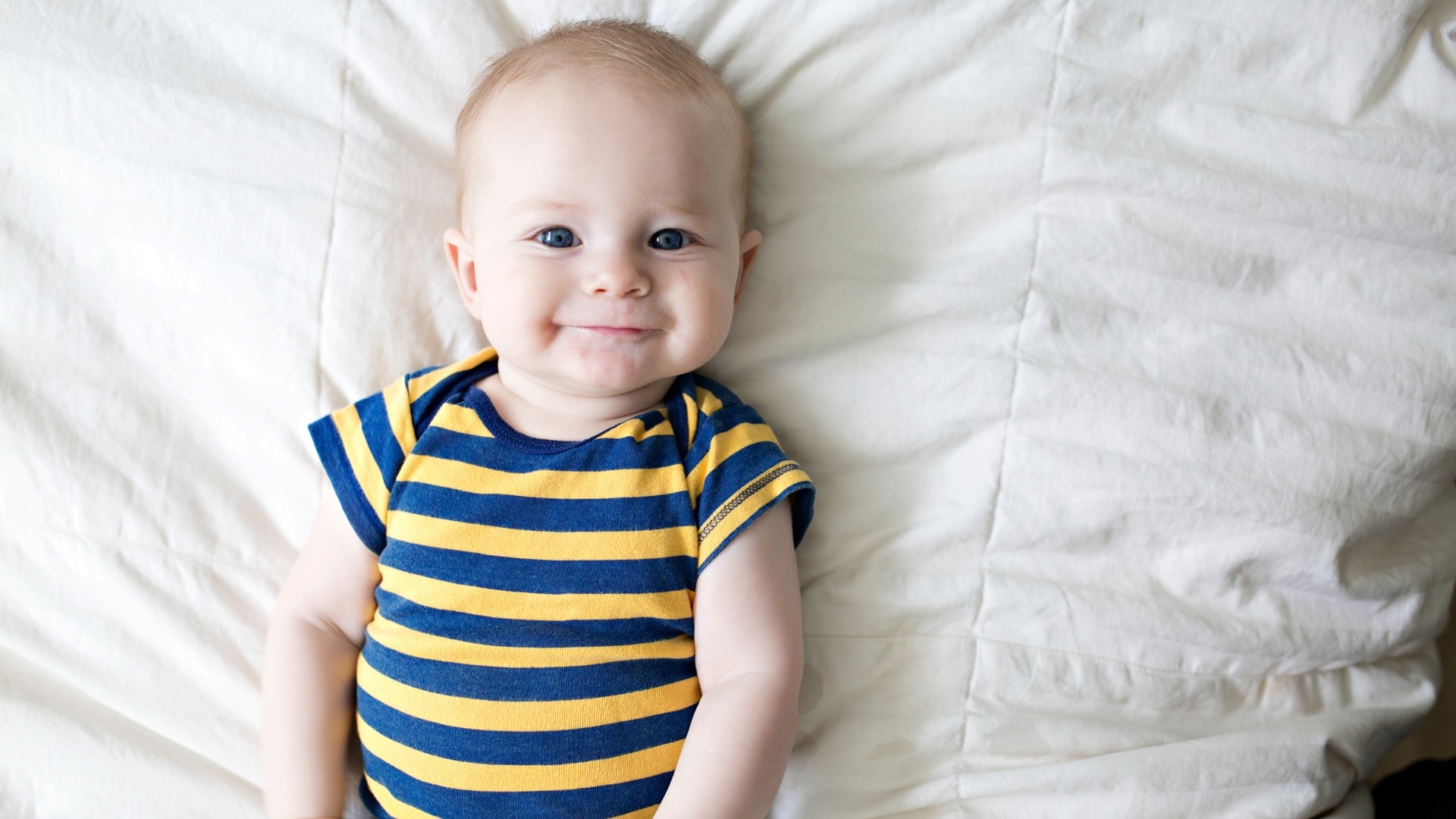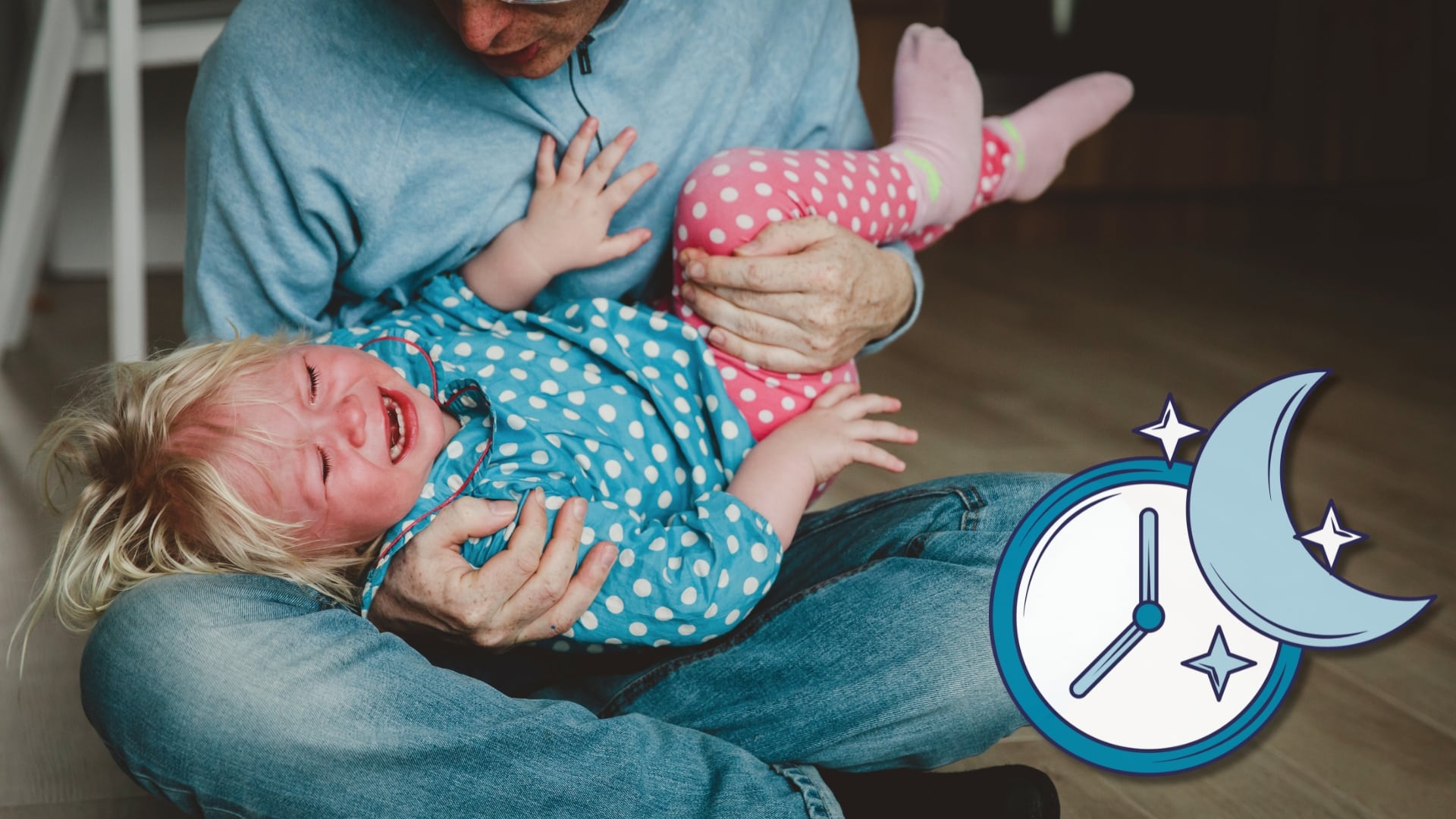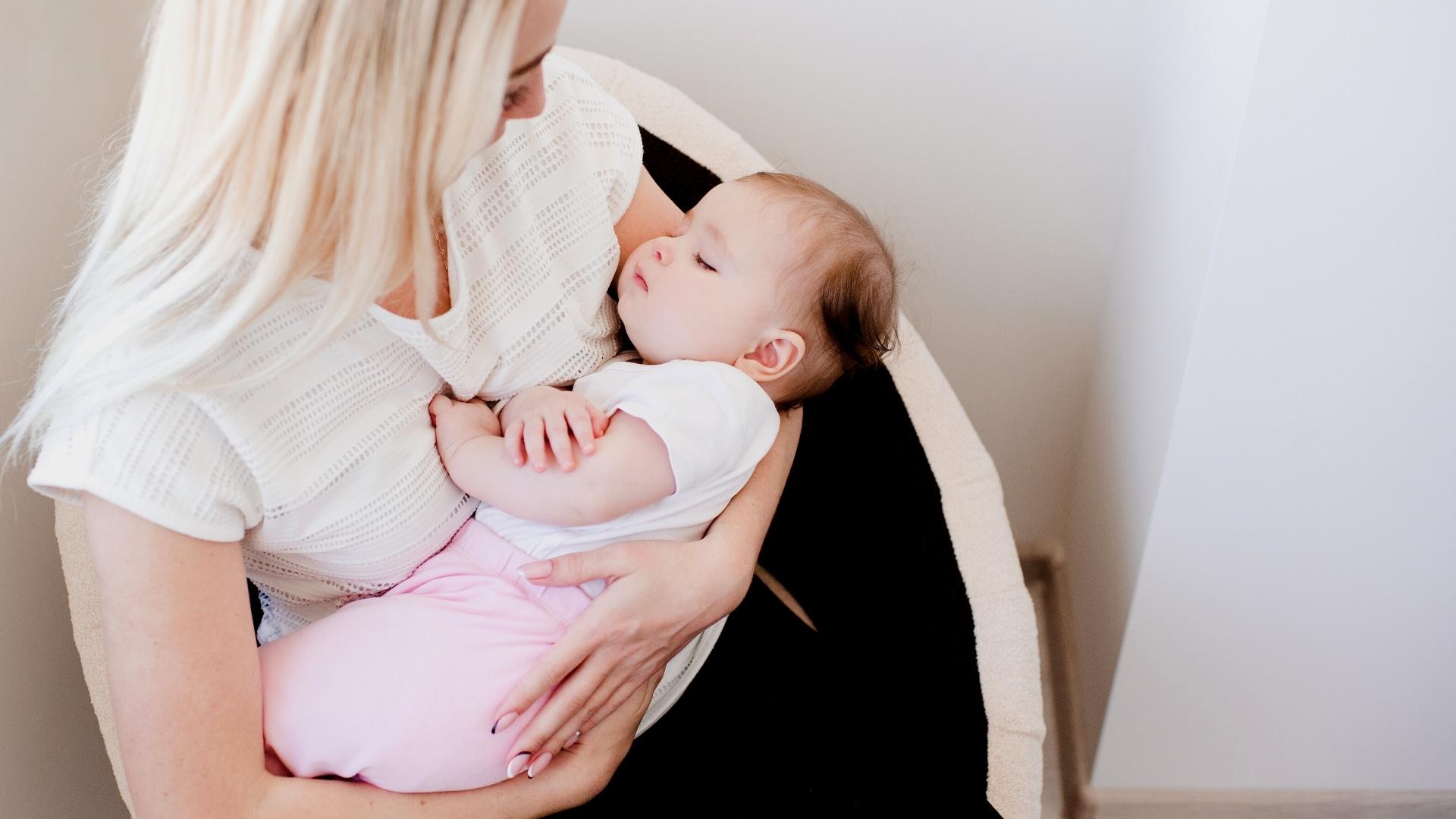Is your upcoming family vacation filled with excitement and just a touch of anxiety when you think about your baby’s sleep schedule being disrupted? Not to worry – you’ve come to the right place for tips on how to help your baby sleep when traveling.
With some planning, flexibility, and these handy tried and tested tricks, you can travel confidently knowing your whole family will be well-rested. Read on to master the art of traveling with a baby!
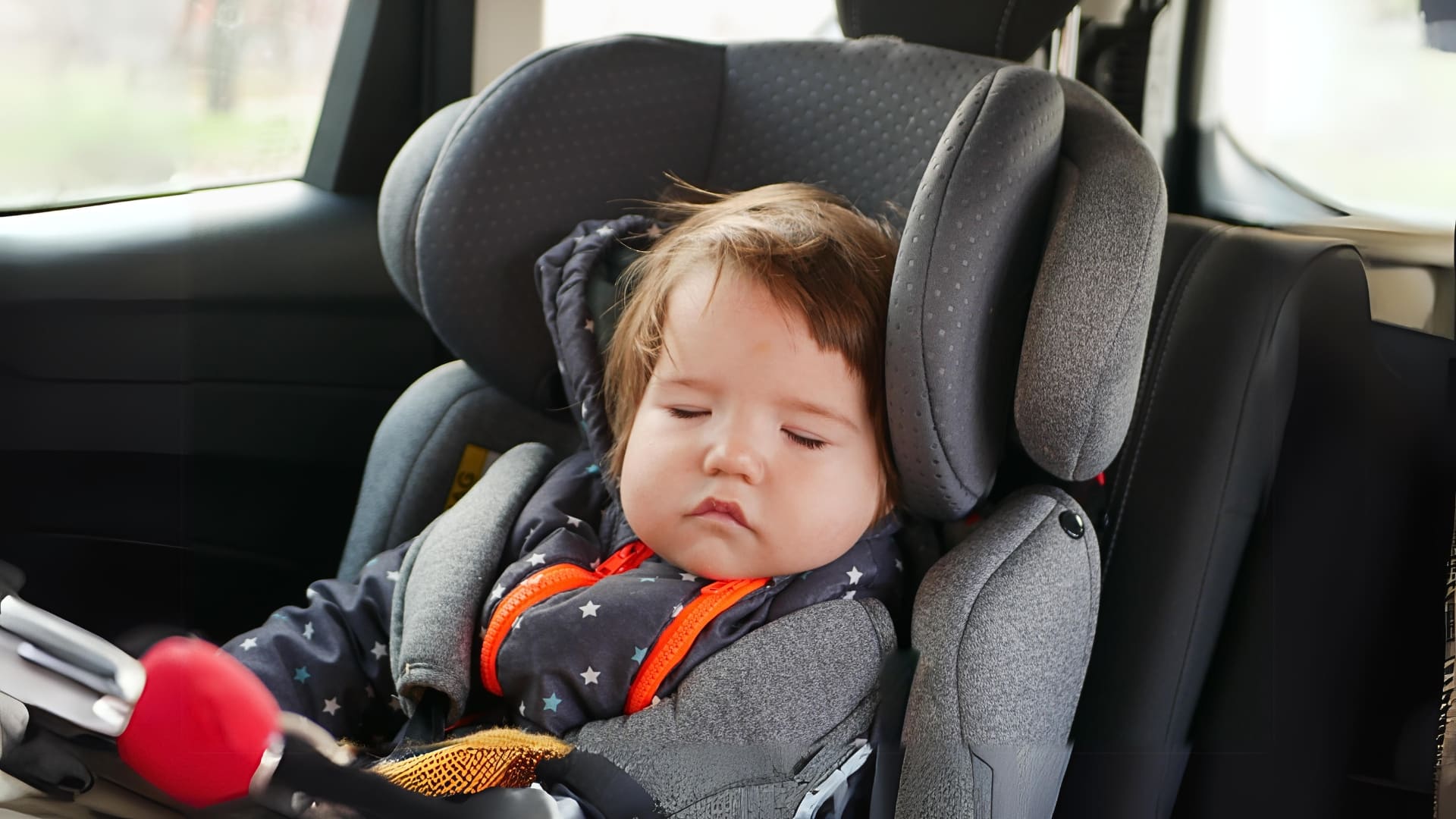
Table of Contents
Key Takeaways
- Try to stick to your baby’s regular schedule for naps, bedtime, etc. as much as possible when traveling. This helps them feel more comfortable and secure in unfamiliar environments.
- Prepare baby’s sleep environment in advance. Bring familiar bedding, a sound machine, blackout shades, etc. to recreate your baby’s sleep setup when traveling. Having consistent sleep associations helps signal it’s time to sleep.
- While routines are important, you need to remain flexible and make adjustments depending on what happens during your trip. Travel schedules, jet lag, and even the mode of transport can affect baby’s ability to sleep when traveling.
Does Traveling Affect Baby Sleep?
Yes, traveling can significantly disrupt your baby’s sleep pattern due to the changes in environment, routine, and time zones. Understanding these influences, however, can help you devise effective strategies to combat their impact on your baby’s sleep.
How Do You Get Your Baby To Sleep While Traveling?
During my career as a nanny (and later as a mother) I have done a lot of traveling with babies and young children. From month-long stays in the Swiss Alps with a newborn to long-haul flights with a 1-year-old, I have experienced firsthand the challenges of keeping your little one’s sleep schedule on track while traveling…
However, as daunting as it can be to travel with your baby, with some careful planning you can travel with infants very successfully.
Here are my top tips to help your little one to sleep while traveling:

- Stick to your routine: Try to maintain your child’s regular sleep schedule as much as possible. This can help them feel more secure and comfortable in a new environment.
- Bring familiar items: Pack your child’s favorite stuffed animal or blanket to help them feel more at home. You can also bring your own crib sheets to make the sleeping environment feel more familiar.
- Use white noise: I always recommend white noise machines and I find them particularly useful when traveling. A portable sound machine or a white noise app can help drown out unfamiliar noises and create a soothing environment for your child to sleep in.
- Use portable black-out blinds: When trying to settle your baby into a routine when traveling daylight can be an issue and keep them awake. Portable black-out blinds will enable you to create an appropriate sleep environment and help your little one sleep for longer too.
- Adjust to time zones: If you’re traveling across time zones, try to adjust your child’s sleep schedule gradually before you leave. This can help minimize the effects of jet lag. On arrival adjust nap times by 10-15 minutes each day and consider bringing forward bedtime until your baby has adjusted to the new time zone.
- Consider a travel crib: A full-size travel crib can provide a comfortable and safe sleeping space for your child, no matter where you are.
- Manage naps: Getting your baby to nap while traveling can be hit or miss, but try to stick to their regular nap schedule as much as possible. You can also plan activities around nap times to help your child get the rest they need. Encourage your baby to sleep on the go if you are out and about rather than having them miss a nap.
- Bring toys for quiet play. If baby will not nap or you know a nap is coming up, make sure you have some calming toys to play with that will keep your baby entertained, without overstimulating. I love this Montessori-inspired UFO toy.
With its colorful UFO-shaped design and soft silicone strands, this wonderful toy provides a tactile experience that encourages sensory exploration and fine motor skill development. Lightweight and portable, it's perfect for on-the-go entertainment and makes a versatile addition to any child's playtime routine!
TOP TIP: Have your baby take naps in their travel crib 1-2 weeks BEFORE you go traveling to help them get used to sleeping in a new environment.
Looking to get your little one to sleep quickly and effortlessly? Check out my Bedtime and Nap Cheat Sheet and master the art of making daytime naps and bedtimes as seamless as possible.
A bedtime & nap cheat sheet so good your little one will ask you to put them to bed...
Laura Williams "This is a life saver! I'm so glad I downloaded your bedtime & nap cheat sheet. My little one actually asked me to put him to bed last night! Unbelievable! Thank you so much!"
Click Here For The FREE Cheat Sheet
Preparing For Traveling With A Baby
As I mentioned earlier, planning is key to ensuring that you make your traveling experience smoother and more enjoyable for both you and your baby.
Here are my hacks for preparing to travel with a little one:
1. Don’t Sacrifice Sleep Essentials
When packing for your trip, make sure to bring along the necessary items for your baby’s sleep routine.
The more similar the holiday sleep environment is to the home sleep environment, the more likely your baby is to sleep without fuss.
Your sleep essentials could include:
- A portable crib, pack n play or bassinet,
- Fitted crib sheets,
- A portable white noise machine,
- Black-out blinds,
- A night light,
- Familiar stuffed animals or blankets,
- Several changes of appropriate sleepwear for the climate (just in case any accidents happen)
Finding the right night light for your child can be quite a task. You want something safe, comforting, and practical. The Cozy Starry Night Light ticks these boxes, with eye-friendly warm lighting and an easy-to-use dimmer.
Its gentle glow makes it the best night light for feeding baby, diaper changes, or comforting your little one back to sleep.
As your baby grows the Cozy Starry Night Light's starry sky projection can provide comfort and gentle quiet time stimulation. Its soft lighting ensures a dreamy, peaceful environment, supporting your baby’s natural sleep cycle.
It really is a fantastic nightlight (at a very reasonable price!)
- Eye-friendly warm lighting with adjustable brightness.
- Includes a timer function for convenience.
- Projects a starry sky that is soothing for little ones.
- Rechargeable battery, so it's very portable.
- A USB adapter is not included for charging.
- The star projector is static without motion (however, this is ideal for very young babies and toddlers).
- Battery life varies based on the brightness settings.
2. Create A Travel Sleep Schedule
Creating a flexible sleep schedule for your baby is incredibly important when traveling. Knowing what you’re going to do BEFORE traveling will help make the journey far less stressful.
Try to stick to a similar routine as you have at home, including a morning nap and regular naps throughout the day.
If it helps, download a sleep-tracking app (like this one called Napper) to help you keep an eye on how much sleep your baby usually has at home, so you can maintain and track it when traveling.
3. Begin Adjusting To Time Zone Changes
If you’re traveling across time zones, adjust your baby’s sleep schedule gradually by 15-30 minutes each day to help them adjust BEFORE your trip.
Jet lag can be tough on babies, so expose them to sunlight during the day and dim the lights at night to help regulate their circadian rhythm. A massage or warm bath before bedtime can also help them relax and sleep better.
REMEMBER: Be flexible and adjust your baby’s sleep schedule as needed to accommodate activities and travel plans. With the right preparation and mindset, you can ensure a safe and well-rested baby while traveling.
Managing Baby’s Sleep During The Journey
When traveling with a baby, it’s important to make sure they are comfortable during the journey. This is important because a happy and content baby is far more likely to nap and relax.
However, making sure baby is comfortable during a journey is a lot easier said than done… So here are a few things you can do to make your travels peaceful.
1. The Tricks To Keeping Baby Comfortable
Make sure your baby is wearing comfortable clothes, has a clean diaper, and is well-fed before you begin your journey.
Always have your well-packed travel bag to hand and don’t forget to pack extra clothes and diapers in case of accidents.
Bring your little one’s favorite stuffed animal or blanket for comfort and if you’re traveling in the evening, consider dressing your baby in their sleepwear so you don’t have to change them during the journey.
Remember to plan your journey around feed and meal times too and make sure you have all the essentials you need to hand to ensure you can feed your little one quickly when needed.
2. Maintain Sleep Routines
When you are traveling from to your destination, stick to your baby’s regular naptime schedule as much as possible, and depending on the length of your journey, try and build that travel time around your baby’s schedule.
For example, if your baby has a morning nap, try to schedule starting your travel during that time so your baby sleeps in the car.
If your trip is long, and your baby is not getting regular naps, aim for at least one good nap a day to keep them well-rested and bring bedtime forward to avoid overtiredness.
TOP TIP: If you are a family that travels a lot, encouraging your little one to sleep in different locations at home and out and about will definitely help them adapt to your travel desires as they grow up.
Reestablishing Baby’s Sleep At Your Destination
When you arrive at your destination, you must get baby’s sleep back on track right away. This is key to a successful holiday that avoids a cranky and overtired baby.
1. Set Up Baby’s Sleep Environment
If you’re staying in a hotel room, ask for a crib or pack-n-play in advance, or bring your own travel crib and sheets to make baby’s sleep environment feel familiar.
This pack-and-play is another gem from Baby Bjorn. With an easy-to-assemble and collapse design, this travel crib comes with a carry bag and is the ideal crib for the on-the-go baby and or toddler! As a bonus, it can also double up a playpen.
If you’re using a travel crib, set it up in a quiet, dark corner of the room. Use a portable white noise machine or a sound machine app to help create a soothing background noise too.
White noise machines are a game-changer for your little one's sleep and having one that plays all night is a must. With a long-lasting battery, this compact and stylish white noise machine contains 21 non-stop relaxing noises, which will lull your little one to sleep night after night, no matter where you are!
If you’re staying with family or friends, ask if they have a spare room or a quiet area where your baby can sleep undisturbed for the duration of your stay.
REMEMBER: In a recent press release titled: Make sure babies have a safe place to sleep when traveling for the holidays. Nick Lyon, the Michigan Department of Health and Human Services (MDHHS) director, reminds us, “Whether you are going to the in-laws or staying in a hotel, make sure your baby has a safe place to sleep. Do not put babies on couches or inflatable mattresses or in bed with siblings or other family members.”
2. Adapt To New Routines
When you’re traveling, it’s important to be flexible with your baby’s routine. This might sound like a contradiction… but try to maintain a consistent sleep schedule whilst being prepared to adjust it if necessary.
For example, if your baby is jet-lagged or struggling to adapt to the new time zone, gradually shift their sleep schedule by 15-30 minutes forwards or backward each day.
Always stick to your baby’s bedtime routine as this will help signal to your baby that it’s time to sleep.
Also, if you’re out and about during nap time, try to recreate baby’s sleep environment as much as possible. Using a stroller or a baby carrier to help your baby fall asleep on the go can work brilliantly.
REMEMBER: Traveling with a baby can be exhausting, so make sure you’re getting enough rest and taking breaks when you need them. And don’t be afraid to ask for help from family or friends. It’s your holiday too.
How To Help Baby Sleep When Traveling On A Plane 🛩️
Traveling on a plane with a baby is one of the most challenging situations a parent can find themselves in. This is especially so when it comes to getting your baby to sleep.
However, with a few tips and tricks, you can make the journey more comfortable for both you and your baby.

- Try to book a night flight: and try and stick to your baby’s usual bedtime routine to help signal to your baby that it’s time to sleep. This is especially important for long-haul flights.
- Dress your baby comfortably: Dressing your baby in pajamas before you leave for the flight will ensure you don’t have to change them in the airport or on the plane. (One less thing to do!) It will also help your baby feel relaxed and comfy – ideal for falling asleep.
- Create a cozy sleeping environment: During night flights the plane lights are dimmed which will help your little one sleep. However, the air conditioning on planes is cool so make sure you bring a blanket or a suitable sleep sack to keep your baby warm during the flight.
- Plan ahead for feeding and diaper changes: Bring enough formula, breast milk, or baby food for the flight, and pack extra diapers and wipes.
- Consider using a baby carrier: When trying to get baby to sleep on a plane, use a carrier as they allow you to move around the plane while keeping your baby close and comfortable.
- Request a baby bed: If you are flying with a US or Canadian airline, you may be given the option of an airline baby bassinet at the boarding gate. It is very much on a first-come, first-served basis, so it is imperative you check in early and get to the gate as soon as possible to secure one.
- Be patient and flexible: Even the best-laid plans can go wrong when traveling on a plane and sometimes you will need to go with the flow. If your baby wants to stay awake and look around at what is going on then don’t try and force them to go to sleep. Watch for sleep cues and then try and settle them. If your baby cries, try not to worry about what other passengers are thinking. I know it’s hard, but worrying about what others think will only stress you out further.
TOP TIP: Try to time your baby’s feeding to coincide with takeoff and landing, as the pressure changes can be uncomfortable for them. Even if it is not time for a feed, offer them a drink as sucking on the bottle will help with any pressure changes that cause ear discomfort.
How to Help Baby Sleep When Traveling On A Train 🚂
Traveling on a train with a baby gives you a bit more flexibility than traveling by plane… But there are still some challenges!
Here are some tips to help your baby sleep when traveling on a train:

- Choose the right seat: If possible, book a private cabin or a seat with a table. This will give you more space to move around and create a comfortable sleeping environment for your baby. Also, try and be near the baby changing facilities on board.
- Bring familiar items: As always, pack your baby’s favorite blanket, stuffed animal, or toy to create a sense of familiarity and comfort in an unfamiliar environment.
- Stick to a routine: Maintain your baby’s regular sleep routine as much as possible. This will help them feel more secure and relaxed. If your baby is struggling to sleep, simply give them the opportunity to have a cuddle and to be calm. Whilst not as restful, this quiet time will help to prevent overtiredness later in the day.
- Use white noise: Bring a portable sound machine or download a white noise app on your phone to help drown out any noise on the train and create a calming environment for your baby. You may find that your baby finds the hum of the train on the tracks very soothing.
- Dress your baby comfortably: Dress your baby in comfortable, loose-fitting clothing that will not restrict their movement. Bring layers to keep your little one at a comfortable temperature.
- Use a baby carrier: Consider using a baby carrier to help your little one fall asleep (especially if they are used to movement to fall asleep at home). A baby carrier also allows you to move around the train without disturbing your baby.
- Be prepared for emergencies: Always have a well-packed travel bag with extra diapers, wipes, and a change of clothes in case of any accidents or spills and whatever you need to feed your baby on the journey.
- Stay calm: Finally, remember to stay calm and relaxed when trying to get baby to sleep when traveling on a train. Your baby will pick up on your energy, and if you are stressed or anxious, they will have a harder time falling asleep.
By following these tips, you can help your baby sleep when traveling on a train and make the journey more enjoyable for both you and your little one.
How To Help Baby Sleep When Traveling On A Boat ⛵️
Traveling on a boat with a baby can be a unique experience… The gentle rocking motion of the boat can help your baby fall asleep, but it can also make them feel uneasy.
Here are some tips to help your baby sleep when traveling on a boat:
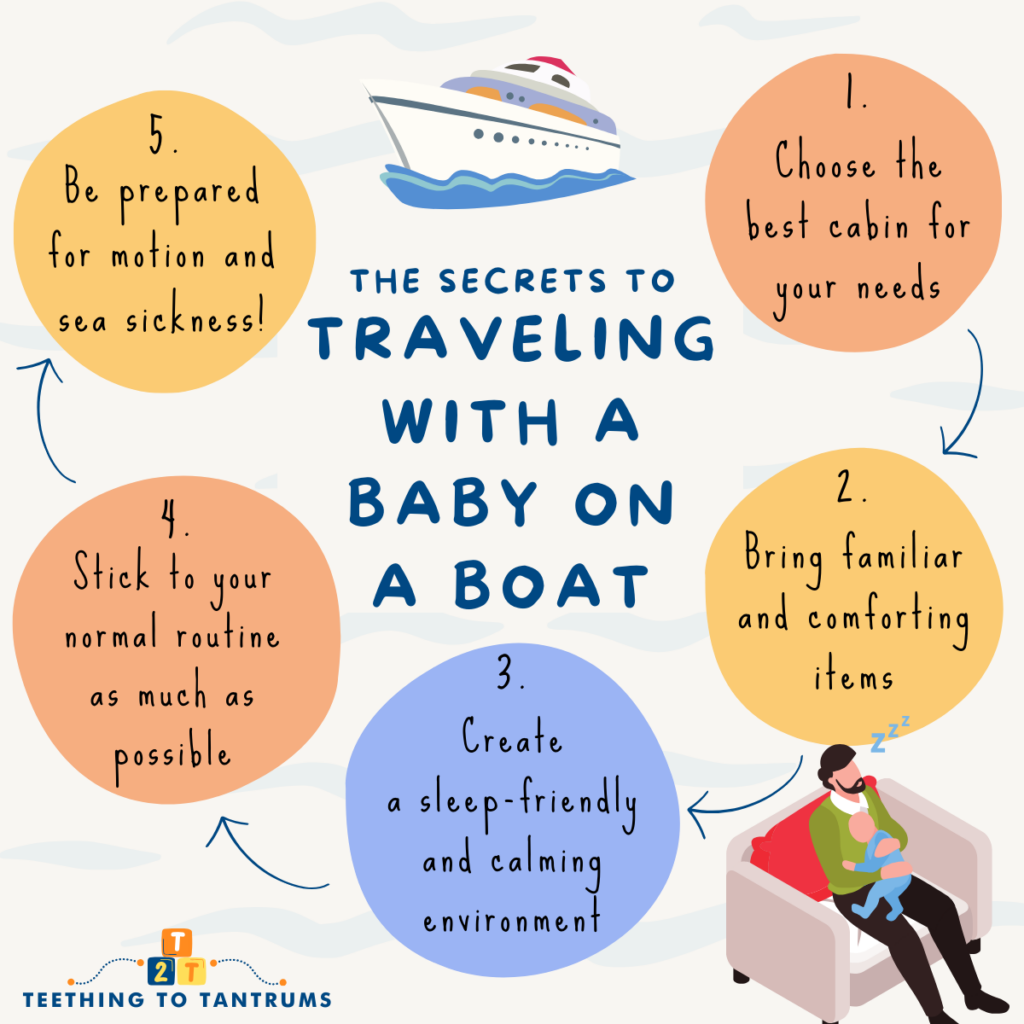
- Choose the right cabin: If possible, choose a cabin that is located in the middle of the boat. This area tends to have less movement, making it easier for your baby to fall asleep.
- Bring familiar items: Bring along your baby’s favorite blanket, pacifier, or stuffed animal. These familiar items will help your baby feel more comfortable and secure in a new environment.
- Create a sleep-friendly environment: Make sure the cabin is dark and quiet. Consider bringing a portable sound machine or playing white noise to help drown out any boat noises.
- Stick to your routine as best you can: Try to stick to your baby’s regular sleep routine as much as possible. This can help your baby feel more comfortable and relaxed, making it easier for them to fall asleep.
- Be prepared for motion sickness: Talk to your pediatrician about medication options to deal with motion sickness prior to traveling. Alternatively, for older babies, you could bring along some natural remedies like ginger candies or sea bands to help alleviate seasickness symptoms.
REMEMBER: Every baby is different, and what works for one may not work for another. Be patient and flexible, and don’t be afraid to try different techniques until you find what works best for your little one.
Frequently Asked Questions About Baby Sleep When Traveling
Looking for more information about baby sleep when traveling? Here are the most frequently asked questions answered.
Q: Where does baby sleep when traveling?
A: During the journey, car seats, bassinets, and baby carriers are all good options for baby to sleep in when traveling. It’s also important to plan ahead for their sleeping arrangements when you arrive at your destination. Many hotels offer cribs or pack-and-plays, but it’s always a good idea to call ahead and confirm availability. If you’re staying with family or friends, consider bringing a portable crib or bassinet.
Q: How do I get my baby to nap while traveling?
A: To get your baby to nap while traveling, maintain your baby’s sleep schedule as closely as possible. Bring along familiar sleep aids, such as a favorite blanket or stuffed animal, to help create a calming environment. If you’re traveling by car, plan to stop frequently for breaks and naps.
Q: Can babies sleep in a pack and play?
A: Yes, babies can sleep in pack and plays, making them a great option for travel. They’re lightweight, portable, and can be set up quickly. Be sure to check the weight limit and age range before purchasing or using a pack-and-play.
Q: What are some alternatives to a travel crib or bassinet?
A: If you’re looking for alternatives to a travel crib or bassinet, depending on the age of your baby consider using a co-sleeper or a travel-sized inflatable mattress. These options can provide a comfortable sleeping space for your baby while on the go.
Q: How do I get baby back onto a sleep schedule after travel?
A: Getting your baby back onto a sleep schedule after travel can be challenging. Try to maintain a consistent sleep schedule as soon as possible after returning home. Stick to your baby’s usual bedtime routine and be patient as they adjust to the change.
Q: Why do babies cry after traveling?
A: Babies may cry after traveling due to changes in routine, environment, or sleep schedule. They may also be experiencing discomfort from changes in air pressure during flights or car rides. Provide comfort and reassurance to your baby, and try to maintain a consistent routine as much as possible.
Need More Parenting Help?
- Download our FREE Bedtime & Nap Sleep Cheat Sheet. It’s a free, easy-to-use and proven formula designed for parents of 0-5 year olds to master the art of consistently undisturbed and restful sleep without the yelling, nagging or exhausting long-winded evenings.
- Check out our Parenting Toolbox. You’ll get access to expertly-chosen products that you can guarantee are the best for your little one and your wallet.
- Are you looking for personalized guidance to navigate the challenges of parenting? I offer 1-on-1 consultations to bring you tailored strategies and actionable advice to help support your child's growth and well-being with confidence.

A bedtime & nap cheat sheet so good your little one will ask you to put them to bed...
Laura Williams "This is a life saver! I'm so glad I downloaded your bedtime & nap cheat sheet. My little one actually asked me to put him to bed last night! Unbelievable! Thank you so much!"
Click Here For The FREE Cheat Sheet




